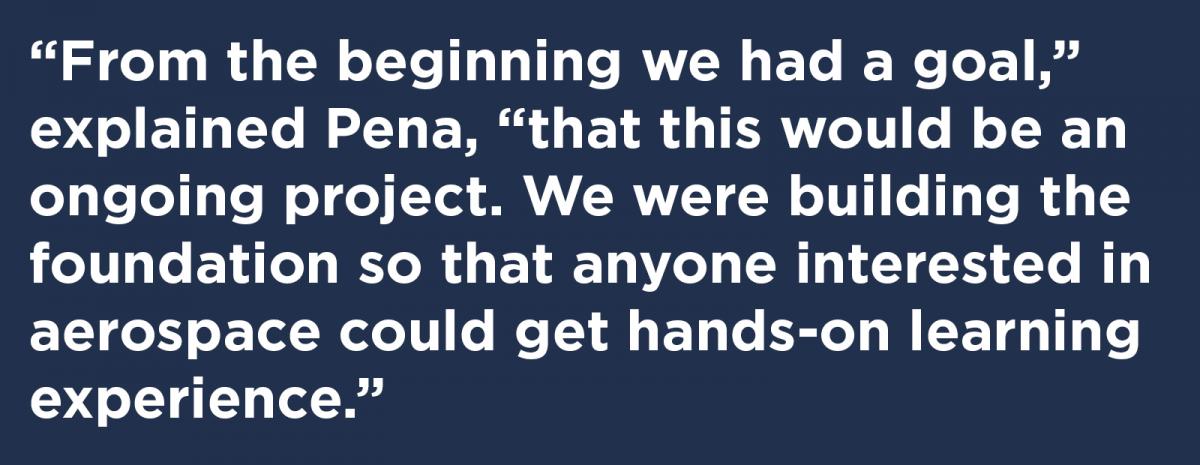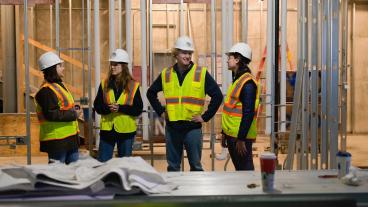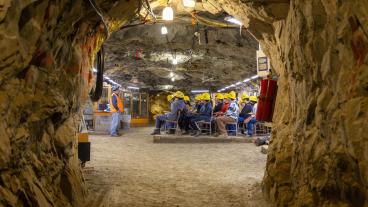In the spring of 2015 undergraduate Dominic Pena approached Sam Drescher, president of the Mines student chapter of American Society of Mechanical Engineers (ASME), with a crazy idea: What if they were to gather students with a shared passion for aerospace at Mines and enter the American Institute of Aeronautics and Astronautics (AIAA) competition?
Each August AIAA releases the new challenge for that year’s Design/Build/Fly competition. It also involves students designing, fabricating and demonstrating the flight capabilities of a radio-controlled aircraft, but each year the specific mission profile changes. Mines had never previously competed.
The challenges were steep. While Mines boasts top-rated mechanical engineering and physics programs, there isn’t an aerospace program. The group would be competing against schools with years of experience, funding, and space for their work.
Nonetheless, Pena and Drescher met throughout the summer and in the fall of 2015 held a meeting with more than 80 students in attendance.
“We knew the interest was there,” said Drescher. “When we polled students in ASME for what topics they would like to see more options for, 70 percent of our members said aerospace.”
Students were asked to submit applications. Eighteen students, mostly mechanical and physics majors, sophomores and juniors, were chosen to form Team Burroworks.

EPICS and Senior Design faculty will be proud to learn of the systematic approach the team took to their design.
Drescher describes the design process as “a total group effort. We broke the 18 of us into two teams. Each team presented three concepts for the planes and then as a group we voted on the best one based on a matrix. We did initial sketches and then Spencer Connor created preliminary designs in SolidWorks.”
“We found an airfield about five miles from Mines,” Pena explained, “and made friends with a lot of mentors out there. The president of the Arvada Associated Modelers acted as a great resource to us, and Dr. Angel Abbud-Madrid (Director of Mines Center for Space Resources) went through safety checklists with us as well as flight checks. He became our faculty advisor. We never had any close calls.”
Initially AIAA’s Design/Build/Fly competition is open to all schools. More than 140 teams submitted proposals and the top 80 made it to the final competition. Burrowork’s final report was ranked 17th best.
“In order to continue in the competition, you have to meet a series of deadlines. If you miss one, you are out. And you have to realize, none of us were doing this work for class credit. We were juggling our course loads, work, activities, athletics or senior design projects for some, all at the same time. So it was truly a passion project. We were all choosing to spend our time and energy on this. That’s what made it so great and the group so close,” explained Drescher.
Despite their disadvantages, the Mines team progressed and on April 13 prepared to leave for the competition in Wichita, Kansas. Some of those very disadvantages became benefits too.
“Compared to the other teams, we had minimal advising, minimal funding, minimal equipment and no space. Our project was stored either at someone’s family garage or in the senior design lab. We just made it work, but it also required that our design be strong and not fragile.”
That strength turned out to be a double-edged sword for the team.
“Many of us had exams the evening before we left for Kansas,” said Pena. “So we just drove all night and got there without much sleep. It was rainy and windy. Only about 30 teams even managed to get one mission done. Several teams built their planes out of balsa with monocot, which is great for weight and very streamlined, but not great for poor weather conditions.”
“Our large plane was carbon fiber and fiberglass mixed composite. The smaller one that was required to fit inside the larger plane was foam with laminate and re-enforced with more carbon fiber on the inside. And that thing was durable. It survived 25 crashes prior to the competition. The only thing that ever broke on it was the landing gear. Luckily we put the prop in the back and so every time we crashed the prop was okay. It was probably about 50 feet in the air with a 2-pound payload hanging below it, and nothing broke. You could definitely tell that mechanical engineers build this as opposed to aerospace students because it weighed a lot, went fast and was durable.”
Ultimately the team finished in 19th place out of 82 teams.
“We were one of the only teams out of the first 17 to actually complete the first mission successfully,” said Drescher. “We were the only team that never had a breakdown or needed repairs. We walked off the field singing the Mines school song. After we did that, other schools starting doing the same thing, but we were the first, even if we weren’t as loud since most had three times as many students there.”
“We were ecstatic to finish as well as we did our first year,” shared Pena. “We beat all the other Colorado schools, and even schools with strong aerospace programs like MIT, Purdue and Berkeley. Just imagine what we could accomplish with more funding and more space!”
Sam Drescher attributes their success to three things: “First, we had a great pilot, Ryan Friedman. And we had Spencer Connor, who had great build knowledge. And finally, we had a team where each person was personally invested – no one was assigned to the team or doing it for a grade.”
Next year AIAA’s Design/Build/Fly will be held in Tucson, Arizona. The team plans to meet throughout this summer and build on their initial success. You can follow along with the team as it designs, tests and reiterates for the 2017 competition via their YouTube channel at CSM DBG Burroworks.
Contact:
Deirdre Keating, Information Specialist, College of Engineering and Computational Sciences | 303-384-2358 | dkeating@mines.edu
Karen Gilbert, Director of Public Relations, Colorado School of Mines | 303-273-3541 | kgilbert@mines.edu



